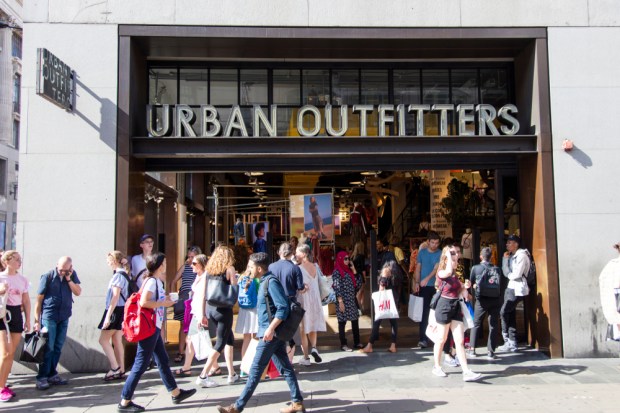Urban Outfitters Gets Too Lean on Inventory

Urban Outfitters put itself on a crash diet that might have gone too far.
As a result of inflation and the unpredictable nature of consumer spending, retailers are implementing strategic and streamlined methods to manage their product inventory by reducing their offerings and aiming for more frequent inventory updates to maintain customer interest. Urban Outfitters was among the retailers trimming down and saw decreasing wholesale revenue during the quarter.
In the first quarter ending April 30, Urban Outfitters experienced an upswing in performance alongside its other brands. Out of the five brands, four achieved record-breaking revenues, contributing to a 6% growth in total URBN revenue compared to the strong first quarter of the previous year. Double-digit sales growth in-store and digital channels were observed in the Anthropologie, Free People and FP Movement brands. The growth compensated for the negative comparable sales at the Urban Outfitters brand and drove a 5% increase in overall comparable sales within the retail segment.
The company’s apparel rental service, Nuuly, continued to receive an overwhelmingly positive response to its unique business concept and product offerings. Nuuly witnessed an exceptional year-over-year revenue growth of 125%, primarily fueled by a substantial increase in active subscribers, reaching 167,000 by the end of the quarter. Nuuly’s contribution to additional revenue amounted to $29 million compared to the previous year’s first quarter.
However, there was a decline of 11% in wholesale revenue during the quarter. This decrease was mainly influenced by some larger partners opting to maintain leaner inventory levels and placing smaller orders.
Too Lean, Too Quick With Urban Outfitters?
“I believe that when we planned the quarter, we planned inventory a little bit too lean, particularly in the women’s apparel area and sort of didn’t allow the women’s apparel sales to bloom as well as they may have if we have had a little bit more inventory,” said Richard Hayne, president and CEO of Urban Outfitters, on the earnings call.
“I feel like from a product perspective and a flash inventory perspective, the brand did intentionally go into the quarter with controlled inventory levels. And like Dick said, maybe too controlled in some places, but to bring back the health of the business, I think that was really an important step,” said Sheila Harrington, global chief executive officer, Urban Outfitters and Free People Groups.
According to the company, the Urban Outfitters brand experienced a 13% decline in comparable sales (comp) within the Retail segment during Q1. The negative comp performance was attributed to disappointing results in North America and a slowdown in the previously positive comp performance of the Urban business in Europe.
In North America, both the physical stores and digital channels recorded negative double-digit comp sales. Within Europe, the weakness was primarily observed in the U.K., while the rest of Europe maintained positive comps. As previously mentioned, it is believed that the macro environment in North America has disproportionately affected the Urban Outfitters customer base and has begun to impact the U.K. customer as well.
Retailers Say There’s Too Much Inventory
As inflation rates rise, consumers have actively sought ways to curtail their spending, primarily focusing on discretionary expenses. Consequently, these actions have repercussions for retailers, impacting their businesses and overall performance. Take, for example, Bed Bath & Beyond.
“Thank you to all of our loyal customers. We have made the difficult decision to begin winding down our operations,” said Bed Bath & Beyond at the top of its website on Sunday (April 23), which declared bankruptcy months after warning about its future.
The 52-year-old home goods seller faced its demise as it failed to secure the necessary funding to sustain its operations and remain in business.
According to The Wall Street Journal, Bed Bath & Beyond’s (BBBY) fate was partially determined by its inability to compete effectively with online retailers and a poorly timed adoption of private-label products, ultimately sealing its destiny.
On the surface, the company’s strategic shift toward private labels during the pandemic seemed logical, as it offered the potential for higher margins and differentiation from competitors. However, analysts and former employees revealed to the Journal that BBBY’s private label strategy faltered due to several factors, leading to its eventual breakdown.
The transition occurred when the COVID-19 pandemic severely impacted global supply chains, resulting in shipping delays and increased costs, making it challenging for BBBY to maintain well-stocked shelves. Former employees also contended that BBBY introduced many private brands too rapidly without the necessary infrastructure to sustain them.
Subsequently, sales declined as the demand for goods diminished in the post-pandemic era.
Read more: Bed Bath & Beyond Bankruptcy Blamed on Private Label Strategy
While inventory is not directly called out, the lean into various private label offerings coupled with its “big blue mistake” — the longstanding coupon strategy of sending 20% discount coupons to numerous households — put the retailer in a predicament where profits were affected and a surplus of inventory failed to resonate with their target customer demographic.
The company’s former president, Arthur Stark, acknowledged that the tactic employed turned out to be an unfavorable long-term strategy.
“Once you’re addicted to it and your customer is addicted to it, it’s a very difficult thing to wean them off of,” he said.
Allbirds Spreads Itself Too Thin
Back in March, Allbirds, the direct-to-consumer (D2C) shoe company, announced its decision to refocus its efforts on its core demographic of “largely affluent” 30- to 40-year-old men and women with interest in an active urban lifestyle.
As part of its strategy to broaden its product offerings and appeal to a wider customer base, the brand made this decision to expand beyond its core customer profile.
“We overemphasized products that extended beyond our core DNA,” CEO Joey Zwillinger said during a March 9 earnings call.
Ultimately, The decision was unsuccessful, as it resulted in Allbirds accumulating excess inventory that had to be heavily discounted to mitigate the situation.
See also: Allbirds Goes Back to Basics as Efforts to Attract New Customers Fail
Macy’s Forays Into Smaller Inventories and Strip Malls
To enhance customer engagement and promote faster inventory turnover, Macy’s has adopted a strategy of reducing inventory levels and exploring opportunities in strip malls.
Macy’s has introduced two new store formats, Bloomie’s and Market by Macy’s, which are significantly smaller than the company’s traditional Macy’s and Bloomingdale’s locations. These new stores occupy approximately one-fifth of the space found in the conventional Macy’s and Bloomingdale’s outlets.
Macy’s off-mall stores strategy has yielded positive outcomes thus far, as these stores have outperformed the rest of the company in terms of sales. In the holiday quarter, Market by Macy’s witnessed an 8% growth in comparable sales, while Bloomie’s reported an impressive 12% growth. These figures include stores open for over a year, incorporating licensed departments.
See: Macy’s Expands to Strip Malls With Smaller Stores and Leaner Inventory
For all PYMNTS retail coverage, subscribe to the daily Retail Newsletter.

